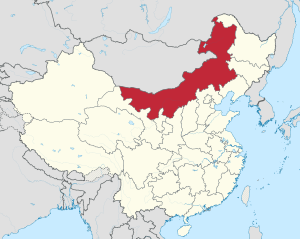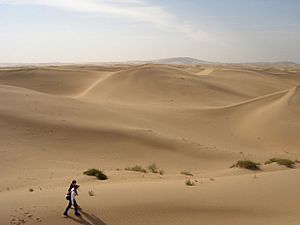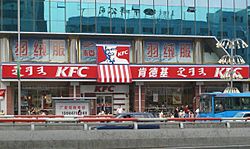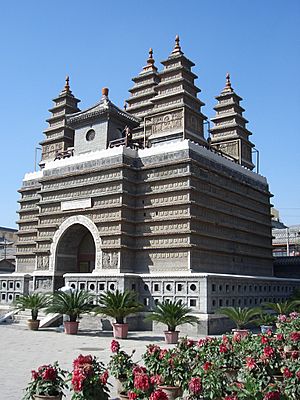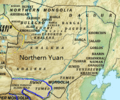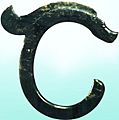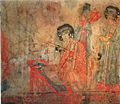Inner Mongolia facts for kids
Inner Mongolia (Mongolian: ![]() , Öbür mongɣul; Chinese: 内蒙古; pinyin: Nèi Měnggǔ; occasionally romanized to Nei Mongol) is the Mongol autonomous region of the People's Republic of China and lies in the north of the country.
, Öbür mongɣul; Chinese: 内蒙古; pinyin: Nèi Měnggǔ; occasionally romanized to Nei Mongol) is the Mongol autonomous region of the People's Republic of China and lies in the north of the country.
Inner Mongolia borders, from east to west, the provinces of Heilongjiang, Jilin, Liaoning, Hebei, Shanxi, Shaanxi, Ningxia Hui Autonomous Region, and Gansu, while to the north it borders Mongolia and Russia. It is the third-largest subdivision of China spanning almost 300 million acres or 12% of China's land area. It has a population of about 24 million. The capital is Hohhot.
The majority of the population in the region are Han Chinese, with a large Mongol minority. The official languages are Standard Mandarin and Mongolian, the latter written in the classical alphabet.
Contents
Name
In Chinese, the region is known as "Inner Mongolia", where the terms of "Inner/Outer" come from Manchu dorgi/tulergi. Inner Mongolia is distinct from Outer Mongolia, which was a term used by the Republic of China and previous governments to refer to what is now the independent state of Mongolia plus the Republic of Tuva in Russia. In Mongolian, the region is known as öbör mongγol where öbör can mean south, inner, front, bosom, breast.
Demography
Han Chinese are the largest ethnic group, about 80% of the population. Mongols are the second largest ethnic group, about 17% of the population. There are more Mongols living in Inner Mongolia than in the independent nation of Outer Mongolia.
| Ethnic groups in Inner Mongolia, 2000 census | ||
|---|---|---|
| Nationality | Population | Percentage |
| Han Chinese | 18,465,586 | 79.17% |
| Mongol | 3,995,349 | 17.13% |
| Manchu | 499,911 | 2.14% |
| Hui | 209,850 | 0.900% |
| Daur | 77,188 | 0.331% |
| Evenks | 26,201 | 0.112% |
| Koreans | 21,859 | 0.094% |
| Russians | 5,020 | 0.022% |
Excludes members of the People's Liberation Army in active service.
Tourism
In the capital city Hohhot:
- Dazhao Temple is a Lamaist temple built in 1580. Dazhao Temple is known for three sites: a statue of Buddha made from silver, elaborate carvings of dragons, and murals.
- Xiaozhao Temple, also known as Chongfu temple, is a Lamaist temple built in 1697 and favoured by the Qing Dynasty emperor Kangxi.
- Xilituzhao Temple is the largest Lamaist temple in the Höhhot area, and once the center of power of Lamaism in the region.
- Zhaojun Tomb is the tomb of Wang Zhaojun, a Han Dynasty palace lady-in-waiting who became the consort of a Xiongnu ruler.
Elsewhere in Inner Mongolia:
- The Mausoleum of Genghis Khan, the cenotaph of Genghis Khan, is located in Ordos City.
- Bashang Grasslands, on the border close to Beijing, is a popular retreat for urban residents wanting to get a taste of grasslands life.
- The Arshihaty Stone Forest/Hexigten UNESCO Geo Park, has magnificent granite rock formations formed from natural erosion.
- Xiangshawan, or "singing sands gorge," is located in the Gobi Desert and contains numerous tourist attractions including sand sledding and camel rides.
- Five-pagoda Temple in the capital of Inner Mongolia Hohhot. It is also called Jingangzuo Dagoba, used to be one building of the Cideng Temple.
Images for kids
-
Persian miniature depicting Genghis Khan entering Beijing
-
Inner Mongolia and Outer Mongolia within the Qing dynasty, c. 1820
-
Theater in Hohhot
-
Temple of the White Sulde of Genghis Khan in the town of Uxin in Inner Mongolia, in the Mu Us Desert. The worship of Genghis is shared by Chinese and Mongolian folk religion.
-
Fresco from the Liao dynasty (907–1125) tomb at Baoshan, Ar Horqin Banner
-
Khitan people cooking. Fresco from the Liao dynasty (907–1125) tomb in Aohan Banner
-
Maidari Juu temple fortress (Chinese: 美岱召; pinyin: měidài zhào) built by Altan Khan in 1575 near Baotou
-
Dazhao temple (also called Ikh Zuu) built by Altan Khan in 1579
See also
 In Spanish: Mongolia Interior para niños
In Spanish: Mongolia Interior para niños


